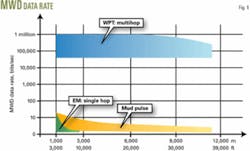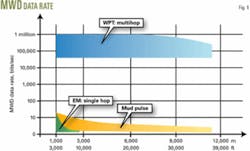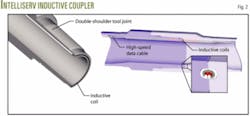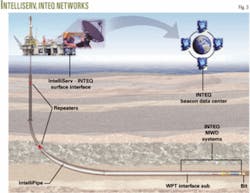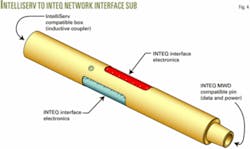New wired-pipe telemetry system tested in Arkoma basin
John Macpherson
Ralf Zaeper
Baker Hughes INTEQ
Houston
Mike Reeves
IntelliServ Inc.
Provo, Utah
BP America received real-time MWD data from Arkoma basin wells through new high-speed wired-pipe telemetry systems that use the Intelliserv network.
The development of a method to transmit downhole measurements from a bottomhole assembly to surface, while drilling, made MWD services possible in the 1970s. The first commercial measurement-while-drilling systems used a train of mud pulses in the fluid- filled pipe bore to transmit data. These early systems were typically capable of transmitting information at data rates of about a half-bit/sec.
Although other telemetry systems-such as electromagnetic telemetry-are currently in use, mud-pulse telemetry (MPT) remains the workhorse of MWD services, and gradual improvements have pushed data rates towards 12 bits/sec under good conditions and closer to 3 bits/sec on deep, difficult wells.
These improvements in data rate were possible due to three parallel developments: a greater understanding of the downhole drilling environment, advancement in electronics and computing, and greater understanding of the transmission channel. Understanding the downhole drilling environment with its extremes in temperature, pressure, and vibration, resulted in a better mechanical design of downhole components.
Parallel advancement in the electronics and computing industries, particularly the development of smaller and higher temperature tolerant components, enabled the design of more rugged, fit-for-purpose, downhole components. Finally, higher data rates demand an in-depth understanding of one of the most complex telemetry channels currently used in any industry: the drilling pipe bore filled with circulating fluid.
MWD, LWD
In general, the effectiveness of an MWD service depends on the suite of measurements available, the data density the service provides, and the accuracy, reliability, and cost of that service. These characteristics are interrelated since, for example, more sensors (and therefore more measurements from different sensors per unit of time) result in lower data density for any one measurement, assuming transmission rate and ROP remain the same.
So system complexity-simply, the number of MWD sensors in the BHA-directly affects measurement resolution. An example of complexity is the number of resistivity values per foot of measured depth displayed on the real-time MWD log.
Both formation logging data (LWD data, e.g., resistivity, gamma ray, etc.) and drilling data (MWD data, e.g., directional data, weight-on-bit, etc.) compete for the same telemetry capacity. This adversely affects LWD and MWD data density whether measured per unit time or per unit of depth. The growing demand for an increasing number of concurrent measurements has swamped the current mud-pulse telemetry capacity. Sufficient real-time data density can only be guaranteed by sacrificing either rate-of-penetration, the number of MWD or LWD measurements, the digital word-size used to represent each measurement, or all three.
In any case, the result is non-optimal, which affects drilling costs either through increased well duration (drilling with a controlled ROP to provide sufficient data density), poor drilling efficiency, low data density of real-time logs (potentially requiring a repeat logging run), or a requirement to run wireline logs.
Therefore, one significant issue confronting MWD companies is how to provide sufficient telemetry capacity for both current and future services. One solution is using wired-pipe telemetry (WPT). The difference between wired-pipe and mud-pulse telemetry rates is very large (currently 57,000 bits/sec vs. 3 bits/sec). EM and mud-pulse telemetry are both “single-hop” methods, in that only one transmitter-receiver pair are used. Wired pipe telemetry is a “multihop” transmission method (Fig. 1).
Wired-pipe not only relieves the pressure on the telemetry bottleneck, it also creates opportunities for new and improved MWD measurements and services.
Wired-pipe telemetry
One working example of wired-pipe telemetry utilizes a high-speed, bidirectional drillstring telemetry system that is the result of 7 years of engineering and development by IntelliServ Inc., a joint venture between Grant Prideco Inc. and Novatek Engineering Inc. The US Department of Energy partly funded this development (OGJ, July 18, 2005, p. 17). The system is described in some detail in other publications.1
A brief description of the system is that each joint in the drillstring is double-shouldered and contains an inductive coupler (Fig. 2). This allows the data-carrying signal to “jump” each tool joint without the need for physical contact between conductors. Within each joint of pipe, a stainless steel tube in the pipe bore contains the shielded, coaxial data cable.
The cable provides only communications, not power, and the signal is periodically boosted to compensate for power losses at tool joints. Repeater subs, placed at 1,200-1,500-ft intervals within the string, provide signal amplification and have sufficient battery power for 40-60 days of operation. These repeater subs are handled operationally as regular joints of drill pipe.
Several shakeout wells have indicated that the system is reliable and that operational handling of wired-pipe is similar to operational handling of other premium-grade drill pipe. It’s possible to wire drillstring tubulars such as collars, and stabilizers, as well as specialty components, such as jars. Testing has shown that a wired drillstring can be used in all conventional operations in which a standard drillstring is used, including cementing and slick-line operations.
Network
Conceptually, the IntelliServ network acts as a data pipe; data flow through the system from its point-of-acceptance to its point-of-delivery (Fig. 3). Utilizing the IntelliServ network for MWD services is rather simple and employs two interface components, one on the surface and one downhole, to translate data to and from the network.
Examining downhole-to-surface communication-in MWD terms, the “uplink”-downhole MWD information enters the wired pipe network at the interface between the two systems downhole. IntelliServ encapsulates this information in its protocol, transmits it along the network, and delivers it to the MWD acquisition system at the surface.
The MWD downlink is similar, except in the reverse direction, with commands and tool configuration parameters flowing from surface MWD computer systems to downhole MWD tools. Fig. 4 is an example of a downhole interface sub that is contained in an MWD tool. The design is extremely simple: IntelliServ network compatible on the up hole box, Baker Hughes INTEQ MWD compatible on the downhole pin, and a couple of electronic components in between.
The transmission rate for MWD information over the wired-pipe is 57,000 bits/sec with the current version of the IntelliServ network protocol, and it will increase to one megabit/sec in the near future.
Arkoma basin field tests
Over the past year, Baker Hughes INTEQ has successfully connected both its downhole and surface MWD networks to the IntelliServ network and has run MWD services in commercial wells for BP America in the Arkoma basin, Oklahoma.
Baker Hughes INTEQ ran MWD tools of increasing functionality in four wells of a seven-well series. Initially, a battery-powered CoPilot downhole drilling dynamics sub was placed at the top of the BHA, interfaced with the drillstring network.
In subsequent wells, the MWD tool was moved to a conventional location in the BHA, a downhole alternator was added, then LWD measurements, and finally a full MWD/LWD tool with a backup mud pulser (to mitigate the risk of wired pipe failure).
This test campaign demonstrated the following:
• Error-free, high-speed, low-delay, real-time transmission of LWD and MWD data during conventional drilling MWD operations.
• Real-time control of the downhole MWD tool from surface, while drilling, to acquire high-density data sets and change downhole tool parameters.
• Operational deployment of a hybrid WPT-MPT system to provide operational reliability in case of wired-pipe failure.
In this last scenario, the mud-pulse system automatically takes over at a conventional mud-pulse data rate if there is an interruption to wired-pipe communications for any reason. The only change necessary to interface Baker Hughes INTEQ’s downhole system with the IntelliServ network was the addition of an interface sub to handle conversion between the two companies’ protocols.
In other words, WPT is a drop-in addition to, or replacement of, MPT, and all current INTEQ MWD tool suites are compatible with WPT, without modification.
Planned deployments
There are further planned deployments of the WPT system as more wired drillstrings become available and more operators take advantage of the system. The high data rate offered by the network creates opportunities for new and improved MWD measurements and services, including:
• Data volume. The large data capacity of the IntelliServ network results in the maximum resolution time and depth based data while drilling. On MWD jobs, the maximum resolution log-termed the “memory log-is made from a dump of the tool’s memory when the tool is tripped to surface. With wired-pipe it is possible to obtain a memory-log in real-time while drilling on-bottom.
• Memory dumping. This is an obvious consequence of the last point; there is no need to dump MWD tool memory after tripping the tool to surface, which saves rig time.
• Low data error rate. The telemetry method used by the IntelliServ network has data error rates similar to surface computer systems. The 57,000 bits/sec data rate of the current system is the telemetry bandwidth available to network’s customers.
Total network bandwidth is about twice this, and some of the telemetry “overhead” protects data integrity, ensuring correction of any errors that may arise during transmission. As a comparison, telemetry overhead in mud-pulse systems is only about 10% and the transmission channel-the fluid filled pipe bore-is far more complex, so that the bit error rate is higher.
• Bidirectional communication. This improves tool maintenance and tool reliability, as well as enhancing certain applications, such as geosteering with rotary steerable systems.
Applications that are enabled by the high-speed network include closed-loop drilling with the CoPilot downhole drilling dynamics sub and rotary steerable systems (RSS); pore pressure detection-and improved wellbore stability-with seismic-while-drilling (SWD), and high resolution MWD and LWD measurements; advanced geosteering with SWD and acoustic position logging; full-waveform vertical seismic profiling (VSP); high resolution real-time formation imaging; and the list goes on.
There are several references to “seismic” in the list because of two features:
• Clocks on the IntelliServ network can be accurately synchronized, and the need for an independent, accurate MWD clock (an expensive item in the high vibration, high temperature, downhole environment) is avoided.
• High data rate. Seismic data volumes can be quite large (for example, 8 million bits acquired in 10 sec for full waveform VSP) but these data are burst data. That is, seismic data are acquired only intermittently and can be interleaved with other data sources, for a lower average required data rate.
Calculations show that telemetry rates of about 30,000 bits/sec, which are well within the IntelliServ bandwidth, are sufficient to handle full waveform VSP data, even at relatively high drill rates.
Baker Hughes INTEQ demonstrated in the BP wells that MWD services using the wired drillstring developed by IntelliServ are both possible and reliable. High-quality LWD logs while drilling on-bottom, irrespective of MWD tool suite complexity, are just one of the benefits of using wired-pipe telemetry. Other benefits include low delay downhole MWD drilling measurements, closed-loop geosteering, high-speed down linking, and increased MWD reliability.
But the level of change in data rates between mud-pulse and wired-pipe rates is so large-a factor of at least 19,000-that wired-pipe telemetry does not just improve MWD services, it creates an opportunity for new MWD applications. ✦
Reference
1. Reeves, M. et al., “High Speed Drill String Telemetry Network Enables New Real Time Drilling and Measurement Technologies,” IADC/SPE paper 99134 presented at the IADC/SPE conference, Miami, Feb. 21-23, 2006.
The authors
John Macpherson ([email protected]) is the program manager for dynamics and telemetry at Baker Hughes INTEQ in Houston. He holds a BSc (honours, 1974) from the University of Glasgow, Scotland, and is a member of the SPE and IEEE.
Michael Reeves ([email protected]) is vice-president and general manager of IntelliServ Inc. (a Grant Prideco subsidiary) in Provo, Utah. He previously served in several operations management positions with Schlumberger Drilling & Measurements (previously Anadrill) in the UK, US, Saudi Arabia, Dubai, Oman, Germany, and the Netherlands. Reeves graduated in 1994 from Imperial College, London, with a civil engineering degree and is a member of the SPE and IADC.
Ralf Zaeper ([email protected]) is a research and development engineer at Baker Hughes INTEQ, Houston. He has also served as an R&D engineer with Baker Hughes in Germany and as a synchrotron-beam-line consultant with ACCEL Instruments Gmbh, Germany. He holds a Dipl.-Phys. (2000) in physics from the University of Duesseldorf and a Dipl.-Ing. (1998) in mechanical engineering from FH-Duesseldorf. He is a member of the SPE and the Verein Deutscher Ingenieure (VDI).
